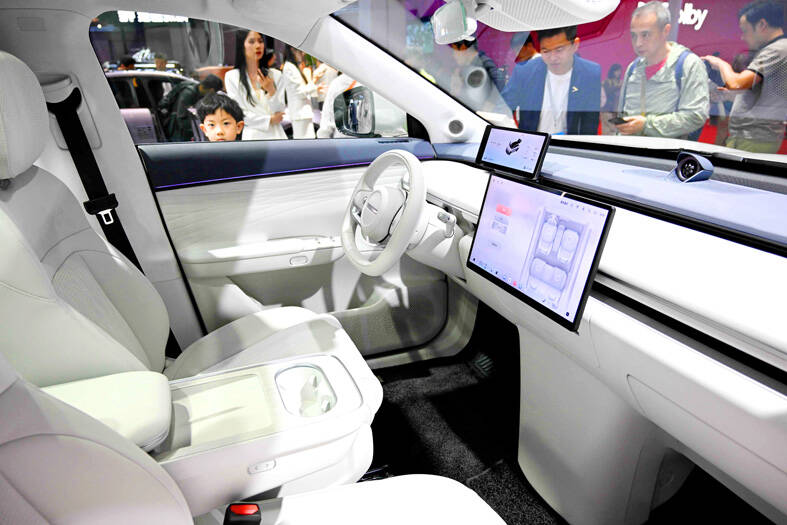Chinese companies such as BYD Co (比亞迪) made their name producing electric vehicles (EV) ahead of the curve, but they have turned to an old-school solution to extend the range of some of their newest models — the gasoline generator.
At the Shanghai International Automobile Industry Exhibition this week, BYD’s luxury Yangwang U8 SUV and other EVs such as Chery’s Exeed ET promised an unusually long range of more than 1,000km.
The secret is a small generator, known as a range extender, which is connected to the vehicles’ batteries and feeds them only when needed.

Photo: Reuters
Because the range extender is not connected to the wheels, the vehicles, known as EREVs, always run in 100 percent electric mode even though they consume gas and emit gases.
This technology grew faster in China last year than any other type of powertrain, the system that propels a vehicle forward.
More than 1 million EREVs were sold, representing a total market share of 6 percent, data from the McKinsey consultancy showed.

Photo: AFP
Range extenders are rare elsewhere at the moment, but that could soon change.
In the US, Stellantis NV plans to offer an EREV version of its star pick-up, the Ram 1500, while its Chinese partner Leapmotor Technologies (零跑) has already launched its C10 SUV in Europe. Volkswagen AG has plans to launch an EREV Scout pickup in the US after unveiling an EREV SUV at Auto Shanghai as part of its renewed push into China. Horse Powertrain, a joint venture between France’s Renault SA and China’s Zhejiang Geely Holding Group Co (吉利控股集團), also presented an engine that can be installed in an electric model.
EREVs fall into the category of rechargeable hybrids, which are seen by manufacturers as a good bet in Europe and North America, where electrification has been slower than expected. They pollute less than gas-powered cars if they are properly charged, while also assuaging driver concerns about range.
According to a survey published by McKinsey on Tuesday, once the concept has been explained, almost one-quarter of customers questioned in Europe and the US said they would consider choosing an EREV as their next car.
“This is a real use identified for the United States, for very American needs,” Stellantis’ Sebastien Jacquet said.
They are suitable for long journeys, but also work well for “pick-ups for towing boats, for example,” Jacquet said.
While an EV has towing capacity, its battery only lasts 100km, he said.
The road ahead is less clear in Europe.
Unlike in the US , there is a planned transition to a 100 percent EV market, AlixPartners managing director Alexandre Marian said, adding that there is a “cut-off point of 2035.”
Some, notably Germany, want exceptions for non-electric but less-polluting motors.
“Who would now invest into new capacities if you know that there’s a natural end to it in 2035?” asked Holger Klein, CEO of German equipment manufacturer ZF. “That’s why we need to solve this very soon.”
Range extenders are a “very good opportunity to reduce the entry cost for people to come to electric mobility,” Volkswagen chief executive officer Oliver Blume said on Tuesday.
However, “in the long term I see the electric mobility as superior”, Blume said.
In a few years battery development would have progressed to the point where those longer ranges will be achievable by pure EVs, he added.

Taiwan Semiconductor Manufacturing Co (TSMC, 台積電) last week recorded an increase in the number of shareholders to the highest in almost eight months, despite its share price falling 3.38 percent from the previous week, Taiwan Stock Exchange data released on Saturday showed. As of Friday, TSMC had 1.88 million shareholders, the most since the week of April 25 and an increase of 31,870 from the previous week, the data showed. The number of shareholders jumped despite a drop of NT$50 (US$1.59), or 3.38 percent, in TSMC’s share price from a week earlier to NT$1,430, as investors took profits from their earlier gains

In a high-security Shenzhen laboratory, Chinese scientists have built what Washington has spent years trying to prevent: a prototype of a machine capable of producing the cutting-edge semiconductor chips that power artificial intelligence (AI), smartphones and weapons central to Western military dominance, Reuters has learned. Completed early this year and undergoing testing, the prototype fills nearly an entire factory floor. It was built by a team of former engineers from Dutch semiconductor giant ASML who reverse-engineered the company’s extreme ultraviolet lithography (EUV) machines, according to two people with knowledge of the project. EUV machines sit at the heart of a technological Cold

AI TALENT: No financial details were released about the deal, in which top Groq executives, including its CEO, would join Nvidia to help advance the technology Nvidia Corp has agreed to a licensing deal with artificial intelligence (AI) start-up Groq, furthering its investments in companies connected to the AI boom and gaining the right to add a new type of technology to its products. The world’s largest publicly traded company has paid for the right to use Groq’s technology and is to integrate its chip design into future products. Some of the start-up’s executives are leaving to join Nvidia to help with that effort, the companies said. Groq would continue as an independent company with a new chief executive, it said on Wednesday in a post on its Web

CHINA RIVAL: The chips are positioned to compete with Nvidia’s Hopper and Blackwell products and would enable clusters connecting more than 100,000 chips Moore Threads Technology Co (摩爾線程) introduced a new generation of chips aimed at reducing artificial intelligence (AI) developers’ dependence on Nvidia Corp’s hardware, just weeks after pulling off one of the most successful Chinese initial public offerings (IPOs) in years. “These products will significantly enhance world-class computing speed and capabilities that all developers aspire to,” Moore Threads CEO Zhang Jianzhong (張建中), a former Nvidia executive, said on Saturday at a company event in Beijing. “We hope they can meet the needs of more developers in China so that you no longer need to wait for advanced foreign products.” Chinese chipmakers are in